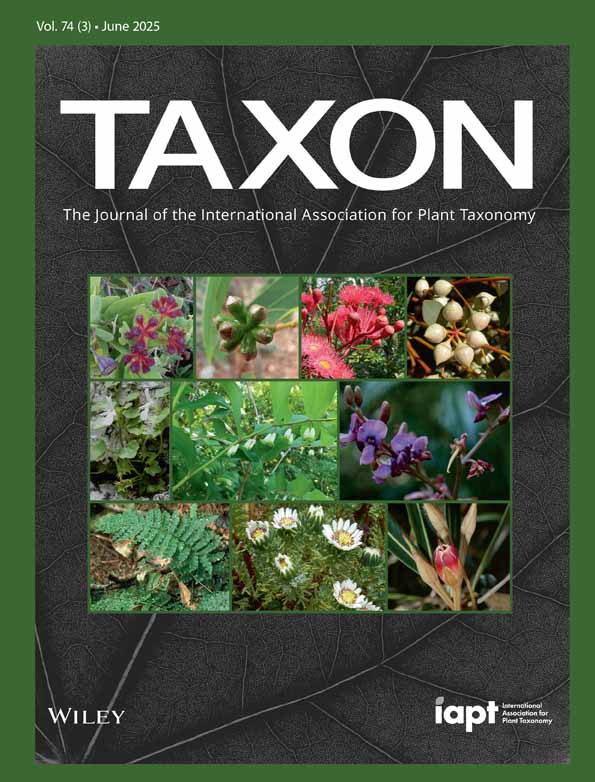The taxonomy of fossil lyginopteridalean fronds Eusphenopteris neuropteroides and their importance for understanding late Carboniferous floristic changes
Associate Editor: Jim Doyle
Abstract
Lyginopteridalean fossil fronds found abundantly in deposits of the Pennsylvanian-age (late Carboniferous) coal swamps have historically been identified as Eusphenopteris neuropteroides. However, these fossils have been referred by Van Amerom to three distinct fossil-species: E. schumannii, E. neuropteroides and E. leonardii. The types of these three species epithets are reviewed and fully documented, as well as the emended diagnoses of the fossil-species. The three species appear to represent a progressive change in frond morphology through Westphalian times, possibly reflecting changes in palaeoclimate and landscape.
INTRODUCTION
The Lyginopteridales is the earliest well-documented order of seed-plants, and is characterised by hydrasperman ovules, compound synangia bearing trilete or monolete pre-pollen, and protostelic or eustelic stems (Anderson & al., 2007). Phylogenetic analyses indicate that this order represents a basal paraphyletic grade in seed-plant evolution (e.g., Hilton & Bateman, 2006). However, the distribution of the order is best revealed through the distinctive bifurcate-pinnate fronds (sensu Laveine, 1993, 1997) preserved as adpressions (Cleal & Thomas, 2023). The earliest well-documented examples of the order are from the Upper Devonian (Rothwell & al., 1989) and then it reaches its maximum diversity in the Westphalian coal-bearing sequences of palaeotropical Euramerica (e.g., Danzé-Corsin, 1953; Patteisky, 1957). The order then gradually declines in diversity through the rest of the Carboniferous (e.g., Van Amerom, 1975; Anderson & al., 2007; Cleal, 2008) and the stratigraphically youngest examples are in the Kungurian (lower Permian; Forte & al., 2018).
Particularly in upper Westphalian macrofloras, the most abundant lyginopteridalean fronds belong to the fossil-genus Eusphenopteris Gothan ex Simson-Schar. nom. cons. (see Boersma & Gastaldo, 1983; Cleal, 2010), characterised by a proximally bipartite architecture, robust, lobed pinnules, and rachises that often show transverse bars caused by sclerotic thickenings (Cleal & Thomas, 2023). The most important taxonomic study of these fronds was by Van Amerom (1975), and most of the species recognised by him are today widely accepted and have been incorporated into the standard floristic models for upper Carboniferous coal swamp macrofloras (e.g., Wagner, 1984; Cleal, 2008; Opluštil & al., 2022). However, there is one fossil-species for which the taxonomy remains ambiguous: Eusphenopteris neuropteroides (Boulay) Novik. Many authors have regarded E. neuropteroides as taxonomically homogeneous (e.g., Kidston, 1923; Bell, 1938), but Scriban (1948) and Van Amerom (1975) suggested that it could be taxonomically subdivided and, from the biostratigraphical data that they give, it seems that the distribution of those taxa may be reflecting climatic and landscape changes that were then affecting the palaeotropical wetlands (“coal swamps”) during Westphalian times. However, uncertainties concerning the circumscription of these taxa and typification of their names has made it difficult to interpret the floristic data. In this paper we therefore review and, in some cases, revise the diagnostic descriptions and types, to put these taxa on a firmer footing.
When referring to the relative ages of the fossil-taxa in this paper we have used the Heerlen Regional scheme as this provides the most reliable chronostratigraphical resolution of the terrestrial deposits in which these fossils occur (Wagner, 1974; Wagner & Winkler Prins, 2016).
MATERIALS
This study has been largely based on adpression fossils from the Westphalian Stage of the Nord–Pas-de-Calais Coalfield, France. The specimens are now in the collections of the University of Lille, France, and are designated catalogue numbers with the prefix designation “USTL” (an acronym for Université des Sciences et Technologies Lille).
PROTOLOGUE OF EUSPHENOPTERIS NEUROPTEROIDES
The species epithet was first used by Boulay (1876), who combined it with the fossil-genus Pecopteris (Brongn.) Sternb. because the pinnules were relatively robust and unlobed, and were compared with those of Pecopteris nervosa Brongn. (≡ Mariopteris nervosa (Brongn.) Zeiller). However, the name Pecopteris neuropteroides Boulay was illegitimate for that species as it was a later homonym of Pecopteris neuropteroides S.S.Kutorga, whose type is a peltaspermacean frond of Permian age (Kutorga, 1844: 75, pl. 4, fig. 3). Although that name is now regarded as a later taxonomic synonym of Neuropteris wangenheimii G.Fisch.Waldh. ≡ Permocallipteris wangenheimii (G.Fisch.Waldh.) Naugolnykh (Fischer von Waldheim, 1840: 239; Naugolnykh, 2014: 12) it still means that P. neuropteroides Boulay was nomenclaturally illegitimate.
The first legitimate use of the species epithet was as Sphenopteris neuropteroides Zeiller (Zeiller, 1883: 186). Although Zeiller only made a passing reference to this species name in a comparison with the Carboniferous fern Myriotheca desaillyi Zeiller, he specifically referred to Boulay's (1876) P. neuropteroides and gave Boulay's pl. 2, figs. 6 and 6bis as the specimens that represent the species; this is sufficient to validate the name Sphenopteris neuropteroides (Art. 38.1, International Code of Nomenclature [ICN] – Turland & al., 2018). Following Zeiller's introduction of the name, S. neuropteroides entered into the literature, and between 1883 and 1968 there were 59 records of the species from late Carboniferous floras listed in the Fossilium catalogus (Jongmans & Dijkstra, 1965, 1968).
As a result of the informal proposal by Gothan (1913) to subdivide the original artificial concept of Sphenopteris, S. neuropteroides was transferred by Novik (1952) to the fossil-genus Eusphenopteris (Simson-Scharold, 1934; Cleal, 2010) resulting in the combination almost universally accepted today: Eusphenopteris neuropteroides (the proposal by Doweld [2003] to transfer the species to another fossil-genus, Lagenospermopteris Doweld, has been deemed to be taxonomically unnecessary and nomenclaturally disruptive, and was rejected: Herendeen, 2011).
TAXONOMIC SUBDIVSISION OF EUSPHENOPTERIS NEUROPTEROIDES
It soon became evident that Eusphenopteris neuropteroides as traditionally interpreted was stratigraphically long-ranging and varied morphologically through its range (Bertrand, 1914a,b). In particular, fronds found in the upper Westphalian were distinctive and were referred to by Bertrand as “forme Leonardi” although no formal diagnosis was given. This taxonomic name was subsequently validated by Corsin (1932: 34), who provided a diagnosis for the forma and illustrated a specimen that may be taken as its holotype (Corsin, 1932: pl. 32, fig. 1). Scriban (1948) further subdivided the original concept of E. neuropteroides into four taxonomic formae based mainly on pinnule morphology: E. neuropteroides f. neuropteroides, f. leonardii, f. schumannii, f. bourozii.
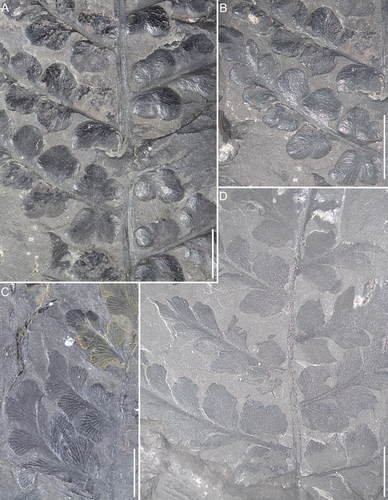
For a long time, this four-fold taxonomic subdivision of Eusphenopteris neuropteroides was not widely recognised, at least partly because the diagnoses were not clear and the nomenclatural types not well documented. However, the detailed monograph of Eusphenopteris fronds by Van Amerom (1975) recognised that the stratigraphically younger fronds (E. neuropteroides f. leonardii) could be distinguished from the types of the species in having smaller, less divided and more subrectangular pinnules. Van Amerom (1975) also distinguished Scriban's E. neuropteroides f. schumannii from typical E. neuropteroides by having fronds that are morphologically more delicate with more distantly spaced pinnae and slender, pyriform pinnules. Scriban's E. neuropteroides f. bourozii was not accepted, however, as the differences in the terminal pinnules and vein density were regarded insufficient to justify differentiation as a separate (fossil-)species from E. neuropteroides.
TAXONOMY
Eusphenopteris schumannii (Stur) van Amerom in Meded. Rijks Geol. Dienst C-III-1, 7: 59. 1975 ≡ Diplothmema schumannii Stur in Abh. K. K. Geol. Reichsanst. Wien 11: 352. 1885 ≡ Sphenopteris neuropteroides-schumannii Scriban in Ann. Soc. Geol. N. 68: 15. 1948 – Holotype: originated from Nowa Ruda (“Neurode”), Lower Silesia, Poland; Schatzlar Formation, lower Westphalian Stage; specimen reported lost (vide Gothan in Abh. Königl. Preuss. Geol. Landesanst., N.F., 75: 21. 1913), illustration: Stur in Abh. K. K. Geol. Reichsanst. Wien 11: pl. 65, fig. 2. 1885.
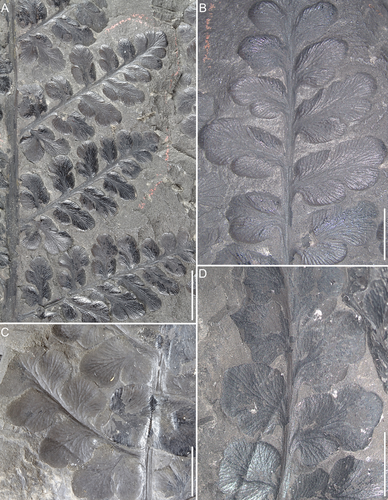
Description
(Fig. 1) Pinnules relatively widely spaced, alternately and obliquely attached to rachis. Pinnules ovate to angular-elliptical with bluntly acute apex, basally constricted with truncate base and often with short broad pedicel. Pinnule margin incised forming up to three lobes, becoming progressively less lobed and more confluent higher in pinna, and eventually entire near pinna apex. Pinnule limb flat, lax, showing clearly marked veins that progressively divide to produce several veins extending into each pinnule lobe. Rachis longitudinally striate, lacking transverse bars.
Remarks
Description based on Scriban (1948) and Van Amerom (1975). Although Stur's holotype was reported lost, several syntypes were stated to be available in Berlin from which a lectotype could be selected (Gothan, 1913). However, this will require the specimens themselves to be checked.
Distribution
Eusphenopteris neuropteroides (Boulay ex Zeiller) Novik in Dokl. Akad. Nauk S.S.S.R. 58(2): 279. 1947, emend. van Amerom ≡ Pecopteris neuropteroides Boulay, Terrain Houill. N. France: 32. 1876, nom. illeg. ≡ Sphenopteris neuropteroides Boulay ex Zeiller in Ann. Sci. Nat., Bot., sér. 6, 16(3): 186. 1883 – Neotype (designated here): USTL 853; originated from Pit Dechy, Aniche, coal seam Eloi; Anzin Formation (Pouilleuse Member), Westphalian Stage (Duckmantian Substage).
The neotype is illustrated in Fig. 2A,B; previously figured by Corsin (1932: pl. 23, figs. 1, 1a).
Description
(Figs. 2, 3) Pinnules relatively closely spaced, alternately and obliquely attached to rachis. Pinnules ovate to angular-elliptical with bluntly acute apex, basally constricted with truncate base and sometimes with short broad pedicel. Pinnule margin incised forming up to seven lobes, becoming progressively less lobed and more confluent higher in pinna, and eventually entire near pinna apex. Pinnule limb flat or slightly vaulted, showing clearly marked veins that progressively divide to produce several veins extending into each pinnule lobe. Rachis longitudinally striate, lacking transverse bars.
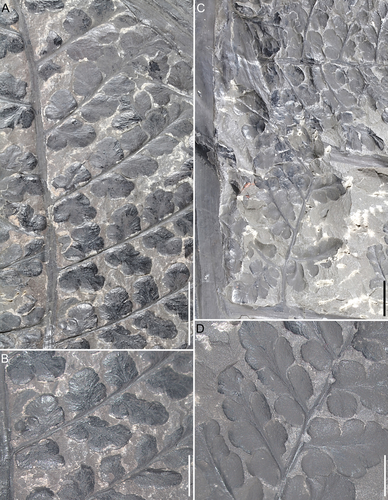
Remarks
Zeiller (1883) mentioned two specimens with the Eusphenopteris neuropteroides protologue (Boulay, 1876: pl. 2, figs. 6, 6bis) and Van Amerom (1975: 54) designated the more complete one in fig. 6 as what he called “Holotypus”, i.e., lectotype. However, despite an extensive search for the Boulay collection we have been unable to locate either of these two syntypes. Since a fossil-species cannot be typified by an illustration (Art. 8.5 of the Code – Turland & al., 2018) we therefore designate here as neotype the specimen figured by Corsin (1932: pl. 23, figs. 1, 1a), which originated from the same general area and stratigraphical interval as Boulay's specimens, and clearly shows the diagnostic pinnule form and venation.
Distribution
Eusphenopteris leonardii (P.Bertrand ex Corsin) van Amerom in Meded. Rijks Geol. Dienst C-III-1, 7: 54. 1975, emend. Cascales-Miñana & al. ≡ Sphenopteris neuropteroides f. leonardii P.Bertrand ex Corsin, Guide Paléontol. [Trav. Mém. Univ. Lille 5]: 34. 1932 – Lectotype (designated here): USTL 827, from Pit No3, Lievin; coal seam Céline, Bruay Formation (Ernestine Member), Westphalian Stage (Bolsovian Substage).
– “Sphenopteris neuropteroides forma leonardii P.Bertrand” in Ann. Soc. Geol. N. 43: 172 (adnot.). 1914, nom. nud.
The lectotype is illustrated in Fig. 4A,B; previously figured by Corsin (1932: pl. 32, fig. 1).
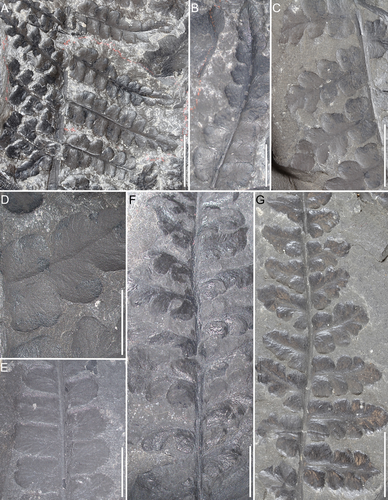
Description
(Fig. 4) Pinnules very closely spaced, alternate and attached at close to right-angles to rachis. Pinnules angular-oval to subrectangular with truncate to broadly rounded apex, and slightly constricted base. Pinnule margin crenate forming up to three lobes, becoming progressively less lobed and more confluent higher in pinna, and eventually entire near pinna apex. Pinnule limb flat or slightly vaulted, showing indistinct fine veins that progressively divide to produce several veins extending into each pinnule lobe. Rachis with transverse bars and longitudinal striae.
Remarks
Description emended from the protologue in Corsin (1932), combined with additional data from Scriban (1948), and from Kidston (1923) who described upper Westphalian specimens as Sphenopteris neuropteroides, which clearly correspond to Eusphenopteris leonardii. Although Corsin had several specimens of this taxon in his collection, we have designated here as lectotype the one specimen that he figured as this is fully characteristic of the taxon. Although Van Amerom (1975) only referred to the name E. leonardii in a short note, he makes direct reference to the basionym in Bertrand (1914b) and Corsin (1932) and so is sufficient to validate the combination.
Distribution
This species is mainly restricted to the upper Bolsovian–lower Asturian of Nord–Pas-de-Calais (Scriban, 1948), southern Britain notably South Wales and Radstock (Kidston, 1923; Cleal, 1997, 2007, 2018), and northern Spain including the Central Asturian and Guardo Coalfields (Wagner & al., 1983; Wagner & Álvarez-Vázquez, 2010), and the Sydney Coalfield of Cape Breton, Nova Scotia, Canada (Bell, 1938).
DISCUSSION
The fossil fronds found in upper Carboniferous coal-bearing deposits of Euramerica that were traditionally identified as Eusphenopteris neuropteroides (≡ Sphenopteris neuropteroides auct.) are now segregated into three distinct taxa: Eusphenopteris schumannii, E. neuropteroides emend. and E. leonardii. The distribution of these taxa can be related to intervals of eustatic flooding of the palaeotropical paralic lowlands, where the coal swamp biome developed (Fig. 5).
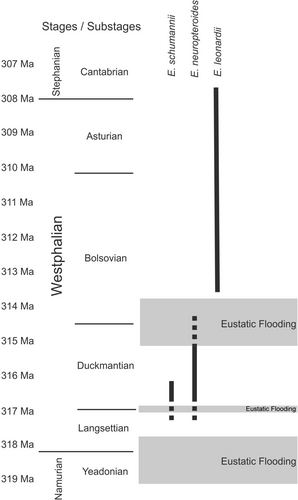
Although Eusphenopteris neuropteroides and E. schumannii first appear in the Langsettian Substage, they do not become abundant until the Duckmantian, when relatively low global sea levels during Glacial Phase C3 of the Late Palaeozoic Ice Age (Fielding & al., 2023) allowed the coal swamp vegetation to reach its maximum diversity (e.g., Cleal, 2007; Cleal & al., 2012; Molina-Solís & al., 2024a). Eusphenopteris neuropteroides in particular may be regarded as a characteristic component of this first major development of the coal swamp biome in palaeotropical Euramerica.
A relatively brief interval of climatic warming towards the end of the Duckmantian (the C3–C4 interglacial of Fielding & al., 2023) caused extensive flooding of lowland palaeotropical Euramerica. This resulted in a significant change to the coal swamp biome (Dix, 1934, 1937; Dix & Trueman, 1937) and is now recognised as a major biostratigraphical boundary between the Lonchopteris rugosa and Paripteris linguaefolia Biozones (Wagner, 1984; Opluštil & al., 2022). One of the notable changes is the replacement of Eusphenopteris neuropteroides by E. leonardii. The reason for this replacement is unclear as we have relatively little evidence as to the anatomy, ecology or reproductive biology of the parent plants. However, the plants producing E. leonardii fronds remained an important component of the coal swamp vegetation through the rest of the Westphalian and into the early Stephanian, eventually disappearing in the early Cantabrian when the coal swamp biome collapsed due to a combination of climate change and orogenic landscape disruption (e.g., Cleal & al., 2009).
The middle Westphalian also saw the development of upland basins in central Europe, notably in Saar-Lorraine and Bohemia, with elevations estimated to have been up to 1000 m (e.g., Opluštil, 2005; Thomas & Cleal, 2017). These upland basins supported a coal swamp biome with similar vegetation (e.g., Opluštil & Cleal, 2007). However, Eusphenopteris leonardii has not been reported from these upland wetlands, its parent plants evidently having been restricted to lowland habitats.
CONCLUSIONS
The recognition of the three fossil-species formerly assigned to Eusphenopteris neuropteroides has important implications for understanding the distribution of this group of lyginopteridalean seed-plants relative to late Carboniferous (Pennsylvanian) palaeoclimatic and landscape changes. The plants that produced E. neuropteroides and E. schumannii fronds were characteristic components of the early Westphalian (mainly Duckmantian) coal swamp vegetation. Following an interval of climatic warming these were replaced by plants producing similar but distinctive fronds (E. leonardii) that were characteristic components of the late Westphalian/earliest Stephanian lowland coal swamp vegetation.
AUTHOR CONTRIBUTIONS
All authors were involved in all stages of preparing this article.
ACKNOWLEDGEMENTS
We thank Jessie Cuvelier for her technical assistance in managing the specimens from the palaeobotanical collections of the University of Lille. CJC acknowledges this institution for providing expenses to support his visits to Lille. BC-M and AM-S further acknowledge the support provided by EARTHGREEN project (ANR-20-CE01-0002-01).



